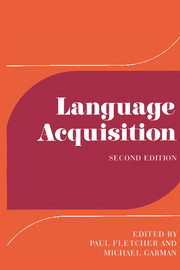Book contents
- Frontmatter
- Contents
- Contributors
- Preface
- Part I Contexts and determinants
- Part II The development of linguistic systems: phonology
- Part III The development of linguistic systems: grammar
- Introduction
- 13 Early vocabulary
- 14 Early syntax
- 15 Assessing morphological development
- 16 Personal pronouns
- 17 Tense and aspect
- 18 Modality
- 19 Deixis
- 20 A crosslinguistic perspective: morphology and syntax
- Part IV Later language development
- Notes to chapters
- Bibliography and citation index
- General index
- Titles in the series
15 - Assessing morphological development
Published online by Cambridge University Press: 05 June 2012
- Frontmatter
- Contents
- Contributors
- Preface
- Part I Contexts and determinants
- Part II The development of linguistic systems: phonology
- Part III The development of linguistic systems: grammar
- Introduction
- 13 Early vocabulary
- 14 Early syntax
- 15 Assessing morphological development
- 16 Personal pronouns
- 17 Tense and aspect
- 18 Modality
- 19 Deixis
- 20 A crosslinguistic perspective: morphology and syntax
- Part IV Later language development
- Notes to chapters
- Bibliography and citation index
- General index
- Titles in the series
Summary
Introduction
Traditionally, morphology or ‘word-structure analysis’ is divided into two broad areas: inflectional and derivational. A morphological construction normally involves the addition of some ‘meaning modifying element’ (such as a prefix, suffix, infix, or even a separate root) to some ‘basic’ root or stem element which carries the ‘core’ meaning of the resulting combination. The construction type (or associated process) is called inflectional if the resulting word is construed to be a mere ‘paradigmatic variant’ of its base (as when the suffix -s is added to the English noun cat to yield its inflected form cats), but derivational if the result is construed to represent an entirely ‘different word’ (as when the suffix -er is added to the English verb teach to yield the derived noun teacher), or when compounds are formed out of two or more roots (e.g. foot + ball = football).
As it happens, the study of morphology in either of these aspects has long been under-represented in the literature, in language acquisition as in psycholinguistics generally, where attention continues to be devoted mainly to questions of (sentence) syntax and (lexical) semantics. As a consequence, though Brown presented a very long chapter on ‘Grammar and the modulation of meaning’ in his influential book (1973), the discussion in that chapter is notable for the relative paucity of data upon which it is based (selected findings from Brown's own longitudinal investigation of the famous triumvirate of Adam, Eve and Sarah, supplemented by the main results from Berko's classic ‘wug’ study, now a quarter of a century old, and very little else).
- Type
- Chapter
- Information
- Language AcquisitionStudies in First Language Development, pp. 326 - 338Publisher: Cambridge University PressPrint publication year: 1986
- 21
- Cited by



